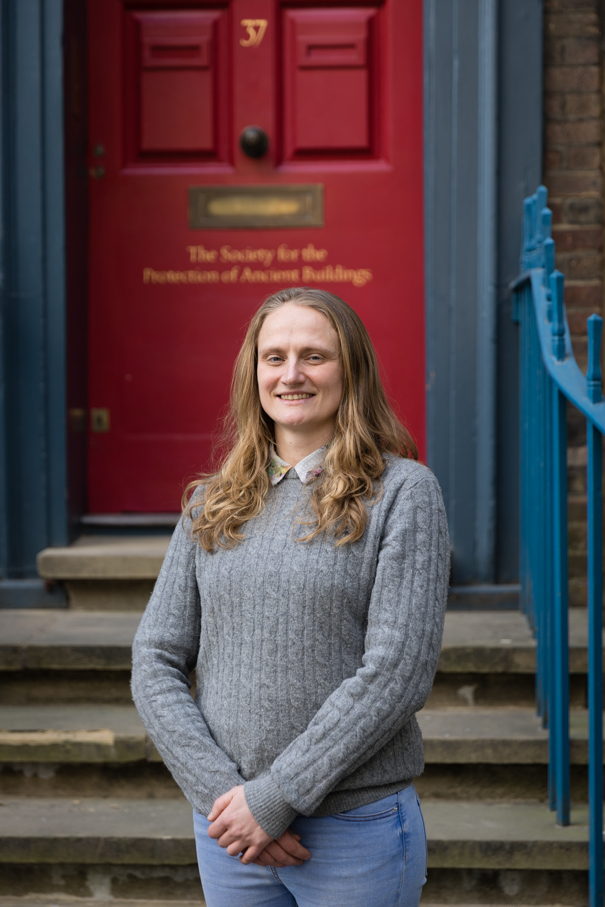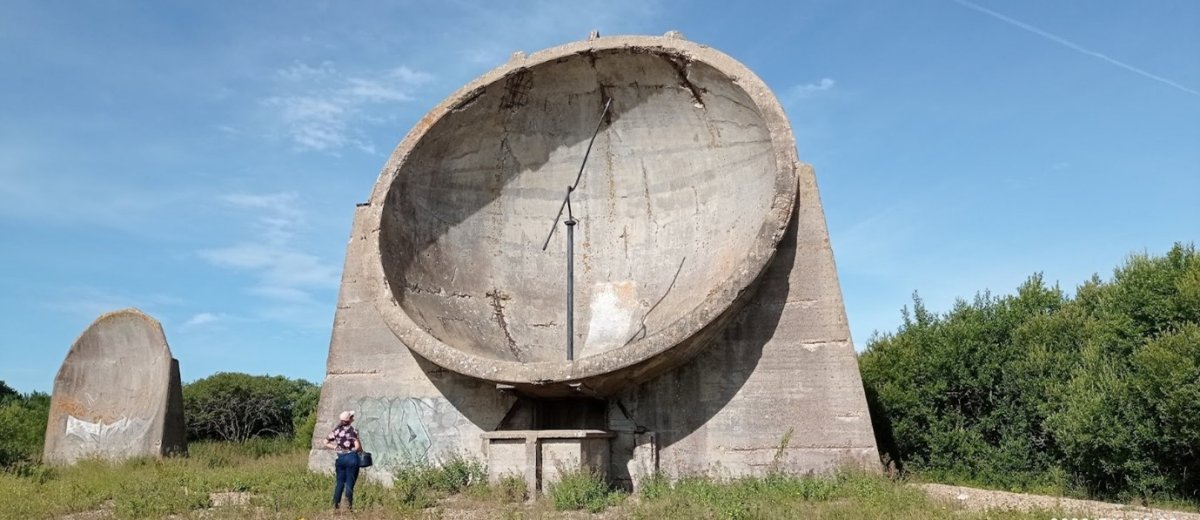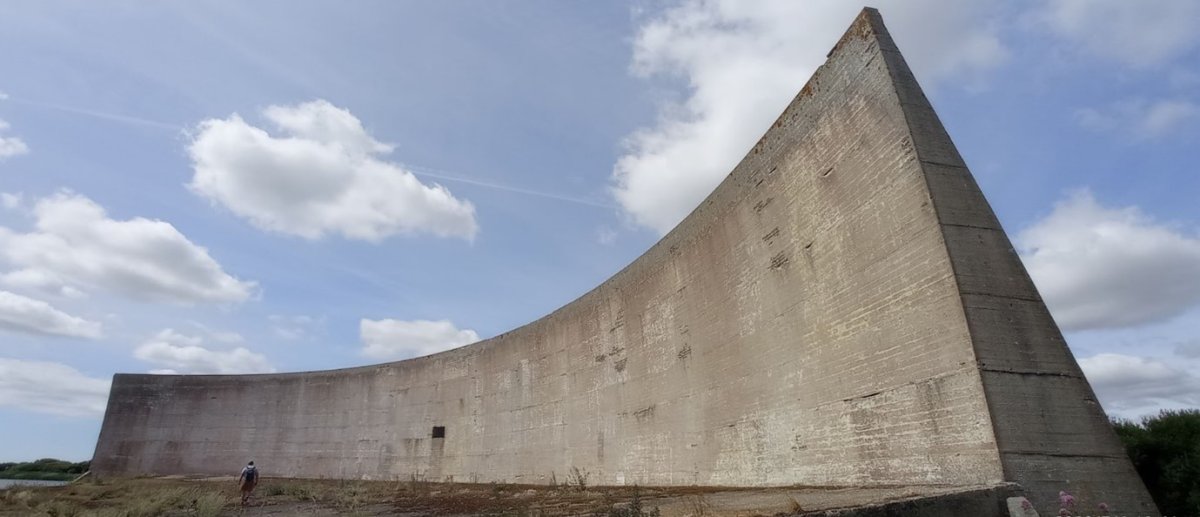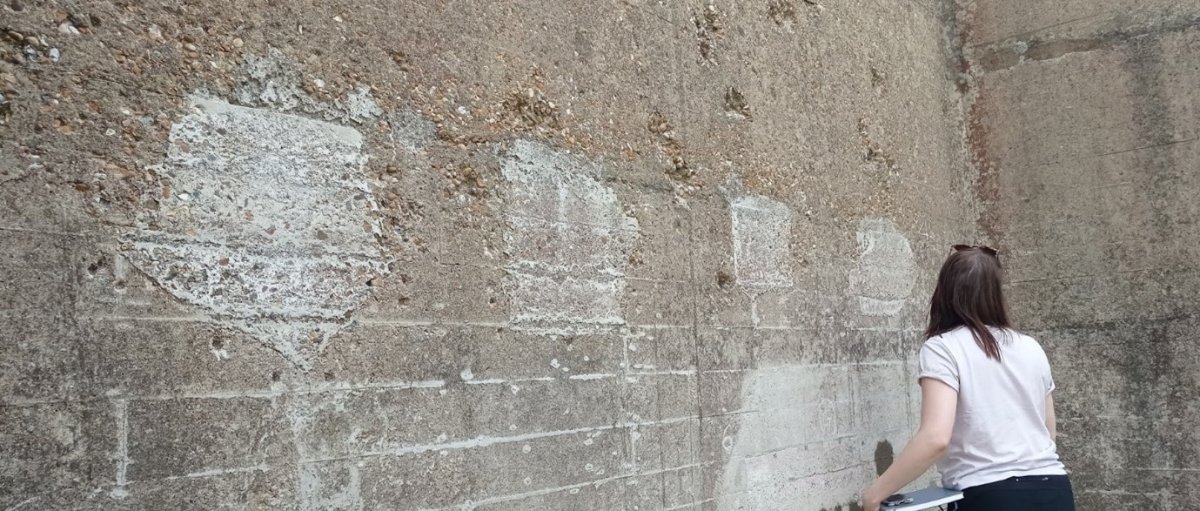A visit to the Denge Sound Mirrors in Kent leaves 2022 Scholar, engineer Katie Hood with many questions...
We are about halfway through the SPAB Scholarship and have seen so many fascinating projects and met so many inspiring people it’s hard to keep track! Sketchbooks at the ready, we have furiously scribbled notes and diagrams about mortars in Roman walls, tiles on Norman churches and timbers in medieval tithe barns.
Katie outside SPAB HQ, London. Credit: Ralph Hodgson.
Perhaps surprisingly however, some of the visits that have got me thinking the most have been to some of the slightly less ancient buildings. Buildings that, almost certainly were not at the front of the minds of Morris and Webb when they were founding the SPAB in 1877 but which, in 2022, are unequivocally part of our countries built historic fabric. Visiting these sites for me sparks a multitude of questions on what, why and how we conserve an evolving heritage. In the spirit of starting discussions, I thought I would throw out some of the questions that have occurred to me on one of these visits. I don’t intend to provide any answers, but, perhaps, if I’m lucky enough to bump into you on the second half of the Scholarship, we can discuss.
The Denge Sound Mirrors, Lade Pits, RSPB Nature Reserve Dungeness. A visit with Historic England Technical Team. Credit: Katie Hood.
The Denge Sound Mirrors are a physical testimony to frenetic interwar military research. These three enormous, reinforced concrete acoustic reflecting dishes represent different phases of a 1920s investigation into acoustic detection of incoming hostile air traffic. A variety of different shapes of mirrors were trialled across the English coastline, culminating in the construction of the largest prototype at Dungeness in 1930. This was 61m long parabola reflecting dish which captured sounds of aircraft from up to 24 miles away and provided up to 10 minutes advanced warning of incoming planes. However, as planes got faster, this wasn’t enough and training exercises showed that even with this warning, incoming bombers could make it to London before interception. Research into alternative technologies finally provided a solution with the invention of Radar in 1935 which rendered the mirrors an obsolete detour in military technologies.
Credit: Katie Hood.
The mirrors at Dungeness were retired and the shingle rich coastline began to be quarried for aggregate. By the 1970s the extractions had significantly undermined some of the ancillary buildings and was encroaching on the mirrors themselves. Exposed to the marine environment the concrete over the shallow reinforcement bars was starting to spall and expose the reinforcement to further corrosion. The sorry state of the sound mirrors led to local concern and eventually listing as a Scheduled Monument in 1979.
By 1999 they were on Historic England’s Heritage at Risk Register and there was significant concern that the smaller mirrors might collapse entirely into the marsh. In the early 2000s, in partnership with the local council and a fund from the aggregate industry, Historic England made a big investment in the stabilisation of the footings of the structures and some localised concrete repairs with full works costing upwards of £700K
Visiting the mirrors in 2022 feels like entering a post-apocalyptic or science fiction movie set. A 20-minute hike from the nearest road, along shifting shingle paths, through a waterlogged landscape and the mirrors appear, continued corrosion and spalling leaving scars and stains across their incongruous curves.
Credit: Katie Hood.
Historic England are currently taking stock of their earlier localised concrete repair work as part of an internationally collaborative investigation of different historic concrete repair techniques. This will inform works on other historic concrete structures going forward. The mirrors are fantastic guinea pigs for these tests, exposed to coastal weather and the associated aggression of salt water. We were lucky enough to get to quiz some of the team on the tests and the outcomes while we were there.
Thinking about the mirrors now, I am left with many questions. As a building nerd with an interest in history, I find them fascinating – but technically the structures were obsolete a decade after they were finished and have not since found a use beyond being an intriguing backdrop for a couple of album covers and a perhaps provided a novelty navigational tool for a few marshland birds. How much we should be doing to protect and conserve the mirrors themselves?
If Historic England collaborations are starting to provide evidence that localised concrete repairs can be carried out successfully and durably to the historic concrete, should we be repairing all spalling and corrosion in the interests of ‘staving off decay by daily care’ (SPAB Manifesto)? Could we justify the budget involved? Should we go as far as preventatively lime washing the full structure to return the pH of carbonating concrete to a level that passively protects steel from corrosion? Should we be ignoring non-dangerous decay, treating only concrete issues of structural concern? Is the decay part of the charm? Or is romanticising the decay the surest road to precocious ruination? What will happen with climate change and changing flood risk? How do these considerations influence the question of repairs?
Perhaps you will have some responses for me when we bump into each other – or perhaps you will have some more questions to add. Either way, I look forward to the discussion.
Could you be a SPAB Scholar? Applications for our 2023 Scholarship are open. Architects, building surveyors and structural engineers who have completed formal training and have experience working in their field are eligible. Find out more about the SPAB Scholarship.




